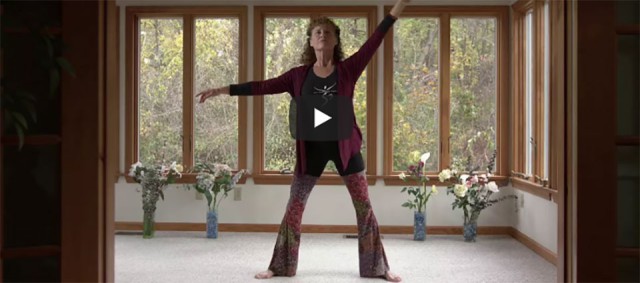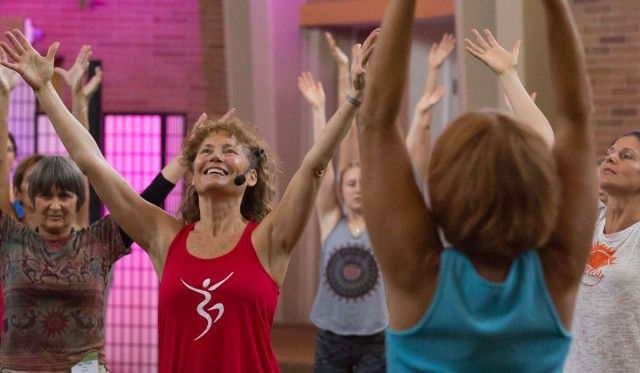Chandra Namaskar: Honoring the Moon Salute

It makes perfect sense that, just as Surya Namaskar (Sun Salutation) honors the energy of the sun, Chandra Namaskara, or Moon Salute, honors the energy of the moon. The Moon Salute, which can be done at any time of day, at the end of your yoga practice or when you simply want to quiet your mind. This restorative sequence, which cools and softens the body, is especially comforting in the evening as a way to wind down and get your body ready for a restful night’s sleep.
There have been many versions of the Moon sequence over the years, but did you know that it was created at Kripalu? Megha Nancy Buttenheim, CEO and founding director of Let Your Yoga Dance® LLC, and a Kripalu faculty member for more than 30 years, co-created Kripalu’s Chandra Namaskar.
Megha explains the evolution of this sequence: “In the late '80s, I wondered why so little attention in yoga was focused on the moon, as did my Kripalu Yoga teaching colleagues. Sun Salutations come from the masculine historical tradition of yoga, but we wanted to make it more accessible to the scores of women who were getting more and more interested in the practice. While the Sun Salutation raises prana, we wanted the Moon Salute to recognize the downward flow of energy.”
This centering, grounding, and flowing practice is a great way to honor the full moon. Megha has used it this way before: “Back in February 2009, there was a supermoon that rose over Playa Guiones, in Nosara, Costa Rica. I invited my Let Your Yoga Dance teacher trainees to do some Sun Salutations facing the Pacific Ocean as the sun went down. After the last rays of sun slipped beneath the horizon, we turned as a group to face a huge full moon in the sky. Together, we flowed with our Moon Salutations, honoring the divine, sacred feminine.”
Megha has since adapted the sequence for those craving a more gentle practice and for those who practice in a chair. “It keeps changing, evolving, and growing with time,” she says. “I consider the salutation to be a meditation in motion and also a prayer.”
She even has a playlist for practicing the Moon Salute. Here are a few of her favorites:
- Deva Premal: “Om Namo Bhagavate”
- Donna de Lory: “Hey Ma Durga”
- Wah!: “Heart Sutra”
- Snatam Kaur: “Deep Blue Sea”
- Ajeet Kaur: “Ra Ma Da Sa Healing”
Classical Moon Salute
Created by Megha Nancy Buttenheim, Deva Parnell, Patricia (Niti) Seip Martin, and Bhumi Harriet Russell
- Stand in passive phase of Mountain pose, hands in Anjali mudra (prayer position).
- Half Moon pose: Bring arms in circle overhead. Arch first to the right side, then to the left side. Return to center.
- Step right leg to the right, with feet at a slight diagonal. Bend the knees, pressing sitting bones down; bend elbows with forearms up, in Victory Warrior Goddess pose.
- Move into Five-Pointed Star, with legs and arms straight, arms at shoulder level.
- Enter into Triangle. Right foot turns out to the right, left foot slowly indents. As you extend your torso to the right, lower your right arm down to the right leg, and raise your left arm directly overhead.
- Pivot body over the right leg, coming into the Standing Runner’s Stretch, bringing your head downward toward the right knee. Hands can rest either on the floor, right foot, shin, or thigh.
- Bend right forward knee, coming down into Runner’s Stretch, with the gaze forward. Back knee can be touching the floor or up off the ground.
- Face front again, in Extended Leg Squat. Toes of extended left leg point upward toward the sky. Look forward. Sitting bones press down, crown presses up.
- Repeat on the other side. Bring hands to floor in front of you and extend your right leg out to the side, entering Extended Leg Squat on the other side. Press your left foot, hands, and right heel into the ground. Press crown of head up.
- Pivot to face left bent leg, entering Runner’s Stretch with left leg forward. Right leg extends straight back.
- Slowly straighten both legs, bringing head toward (or touching) the left knee, entering Standing Runner’s Stretch.
- Slowly pivot again to front, sweeping the right arm up toward the sky, lower arm touching the left leg, entering Triangle.
- Return to Five-Pointed Star by lifting up of out of Triangle, toes turning slightly outward on a diagonal, arms extended at shoulder level.
- Enter Victory Warrior Goddess again.
- Return to Mountain pose by bringing legs together, arms overhead.
- Half Moon pose to left side first, then to the right side.
- Return to Mountain pose, circling arms from overhead back down to Anjali mudra, pressing palms together in front of the heart. Repeat as many times as you wish.
Megha later modified the sequence to create gentle and seated versions of the Moon Salute. She says, “Whatever version you practice, you will be joining thousands of yoga practitioners and teachers who, for three decades, have enjoyed this salute to the divine feminine.”

